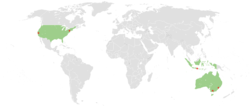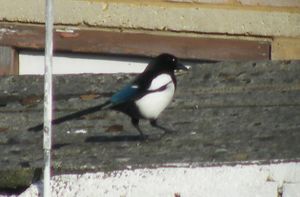Most Glorious People's Republic of A1
This article refers to a micronation or element of micronationalism which is defunct and no longer exists. You can help make the article reflect that or ask on the talk page for further information. |
Most Glorious People's Republic of A1 | |||||||||
|---|---|---|---|---|---|---|---|---|---|
| Motto: Heil Pprit! | |||||||||
| Anthem: Oh Glorious A1! | |||||||||
 | |||||||||
| Capital and largest city | Ppritville | ||||||||
| Official languages | Australian English, Indonesian | ||||||||
| Demonym(s) | A1 | ||||||||
| Government | Democratic Parliamentary Communist Dictatorship | ||||||||
• Chairman | Donald Sunderland | ||||||||
• Deputy Chairman | David Massarde | ||||||||
| Legislature | A1 People's Congress | ||||||||
| Establishment | 1st January 2008 | ||||||||
| Population | |||||||||
• Census | 81 (at peak) | ||||||||
| Currency | Australian Dollar ($), Indonesian Rupiah (Rp) | ||||||||
| Time zone | (UTC+10 or +7) | ||||||||
| |||||||||
This nation was a member of the OAM | |||||||||
The Most Glorious People’s Republic of A1 was founded on January 1 2008, after claiming a small territory in Melbourne, Australia. Within a few months, it had claimed much new territory, and then proceeded to become a prosperous and influential nation, at least within the 'MicroWiki' sphere. It was later reformed as the Republic of Acacia in the Federated Republics of A1 on 4 November 2010.
A1 prided itself on not being a micronation based entirely virtually, but existing mainly in 'real life' through activities such as military exercises, as well as government meetings and projects.
Etymology
The name 'A1' stemmed from the original territory claimed by A1 and where the Pprit Revolution took place. As A1 originated from a classroom 'joke' towards the end of 2007, the original name for the nation was simply 'A1', coming from the name of the classroom ('A1'). Following the Revolution however, the decision was taken to add 'Most Glorious People's Republic of' to the beginning of 'A1', by the order of Chairman Pprit.
History
A1 was previously inhabited by the indigenous population up until the late 1800s.
After the development of the area in the mid 1900s, A1 was created by the urban sprawl of Melbourne.
The main turning point in the history of A1 was the Great Pprit Revolution, where former Chairman Pprit headed a revolution, and declared A1’s independence on January 1 2008. Just a few days later, the government was formed, the Constitution & Bill of Rights written & authorised and territories secured.
Since then, A1 has emerged as a prominent micronation in Southern Australia, even becoming active in other micronational affairs under the direction of Chairman Donald Sunderland, Deputy Chairman David Massarde, and the A1 government.
The 2010 A1 Political Crisis, mainly between former Deputy Chairman Tomas Caulfield's United A1 Party and Margaret Boden's A1 People's Party severely rocked A1's politics. The crisis eventually caused members of the United A1 Party to renounce their A1 citizenship and create a new micronation, the Federal State of A1, resulting in the sparking of the Great Patriotic War.
Demographics
- No. of citizens: 49 (Last census - November 2009)
- Age structure:
- 0–14 years: 4%
- 15–64 years: 96%
- 65 years and over: 0%
- Median age:
- total: 23.1 years
- male: 17.8 years
- female: 25.1 years (2009 est.)
- Life expectancy at birth:
- total population: 81.12 years
- male: 78.21 years
- female: 83.75 years (2008 est.)
- Languages: Australian English
- Literacy: 100%
Government and politics
(See main article – Politics (MGPRA1))
A1 was a democratic parliamentary communist dictatorship. The Chairman was the Head of Government and Head of State.
General Elections were held around every year, with the leader of the political party that has 50% or more of the vote gaining the position of Chairman, however voting was not compulsory on account of difficulties accessing citizens. Elections were overseen by the independent A1 Electoral Commission and were held both online and in 'real life.'
There was also a civil service within the A1 government, which were apolitical appointments (permanent secretary or permanent under-secretary) to certain important ministries or offices, and various other government positions.
The executive government
The government of A1 was decided by the Chairman, and was tasked with the role of running A1. There were two main parts to the government:
- Chairman & Deputy Chairman
- Central Committee
The Central Committee, which was formerly known as 'Cabinet,' held power as being almost directly below the Chairman and hence, exercised significant influence over decisions made by the Chairman and Deputy Chairman.
All members of the A1 government were answerable to the Chairman and the independent court system of A1.

Law and order
(See main article – Law & Order (MGPRA1))
The Judicial Branch in A1 was separated from the legislative and executive branches, to ensure a separation of powers. This ensured that A1's justice system was fair and independent.
The High Court of A1 was the highest court in A1, and dealt mainly with matters concerning the constitution and treason. What was referred to as the 'Supreme Court' dealt with most other matters.
The final head of the High Court was Justice Maximus Ze Blah.
Foreign relations
(See main article – Foreign Relations)
A1 came out of isolation in August 2009, following the August 2009 General Elections, and became an influential micronation, at least within the 'MicroWiki' sphere.
As detailed in A1’s first and only foreign policy, White Paper, one of A1’s main objectives was to obtain recognition by as many entities as possible, so as to elevate its influence and add weight to its claims of sovereignty.
A1 established its first micronational diplomatic relations with Bobalania in July 2009, joined the United Micronations in early August 2009 and the Grand Unified Micronational soon afterwards, but left the GUM in November 2009 due to numerous complaints by A1 about various aspects of the GUM.
The Micronational Assistance Office and the Organisation of Active Micronations were launched in October 2009 in response to the recommendations made by the July 2009 White Paper. These creations were met with great approval from inside the A1 Government and from most of the micronational community.
Dr. Rick Pitts' disapproval of Micronationalism in Antarctica caused much controversy, sparked by the leaking of a speech by Dr. Pitts to the Central Committee in February 2010.
Military
(See main article – A1 Defence Force)
A1 maintained a small non-standing military force, in the form of the A1 People’s Army and the A1 Red Guard, which were essentially the reserve forces of he A1PA. Total numbers in the armed forces were around 70, as conscription at the age of 16 into the Red Guard was currently in force.
The A1DF (A1 Defence Force) was headed by the Supreme Headquarters of the Armed Forces (SHAF), which was headed by the Supreme Commander of the Armed Forces, constitutionally the Chairman. However, in reality, the commander of the A1DF was the General Officer Commanding A1 Defence Forces (GOCA1DF).
The A1DF was only mobilized twice in its history, the most recent being the Great Patriotic War.
Geography and climate

A1 was approximately 5 square kilometres in area, comprising of four protectorates.
Natural hazards of A1 included:
- High winds
- Extreme temperatures
- Severe electrical storms
The now infamous Great Window Opening Tornado Disaster of 2008 was particularly devastating, with over 15 sheets of paper blown across New Central, with one citizen receiving an incision on their arm amongst the many other terrible effects of the disaster. A public holiday to remember the disaster is now held on March 23, the day that this terrible disaster struck.
The A1 Weather Bureau provided weather information for A1, including weather warnings, rainfall, and udometer readings.
Economy
Considering its size, A1 had a relatively large theoretical GDP (based on citizens' incomes) ($US350,000), but had a large deficit in its theoretical Current Account Balance (CAD), mainly due to a disproportion between exports and imports.
A1 imported almost all of its needs, with only a small amount of gas, heating and electricity being exported to A2 and gas bottles to Australia; forming A1’s entire exports.
The unemployment rate was also extremely high (55% in October 2009) due to the country’s young population. 92% of the population is 21 years old or younger.
The A1 government did not release confidential Treasury information, or information on A1's finances and hence, all figures are estimates.
No private enterprise or entity was permitted within A1, with all entities being owned and/or controlled by the Government, with the exception of the A1 News Service.
Infrastructure

The protectorate of Gardiner, established in May 2010, had within it the Gardiner Railway, the only A1-built and owned piece of infrastructure. It was run by the Gardiner Railway Commission (GRC), which was a government owned entity.
The railway moved both goods and passengers, and linked all three communes of Gardiner together, with one railway station in each commune.
Education
All primary and secondary education of A1 citizens was handled by the Victorian Government’s Department of Education and Early Childhood Development, as it was not within A1's realistic scope to provide such services.
The University of A1 was founded in January 2010, offering comprehensive online courses. However, it is not intended as a substitute for 'real life' tertiary education, but merely for qualifications within the micronational world and A1 itself. It was disestablished in late October 2010 pending a new university in the FRA1.
Culture
(See main article – Culture)
The culture of A1 was almost entirely similar to that of Australia’s, with some minor differences.
The official language of A1 was Australian English, and is strictly enforced. Any citizen caught using the U.S form of English was severely dealt with, with the exception of some citizens of Lichthalzen and Nasatroe. This was formalised with the establishment of the A1 Spelling and Grammar Police in October 2009.
Customs
It was considered polite to shut doors behind you, especially on cold mornings.
It was also considered rude to make fun of former Chairman Pprit, interrupt a speech by the Chairman or to make a mockery of A1, as the majority of A1 citizens had a famous nationalism, and were proud of their nation.
It was customary to greet fellow A1 citizens in formal or semi-formal ceremonies with the greeting: “Heil Pprit!”. This greeting should also have been accompanied with the A1 salute, which is essentially the same as the Australian military salute.
Media

Owing to the size of A1, there was only one A1-specific news provider, the A1 News Service, or A1NS, which was funded and owned, but not controlled, by the A1 government. It also provided news from all the protectorates.
In September 2009, the A1 Broadcasting Commission was begun. It, similar to the A1 News Service, is funded by the government, but is run by a board of directors, and maintains a YouTube Channel and Livestream Channel.
The Arts
Although having much musical and artistic talent, A1 did not ever have a performing arts centre or artistic academy.
There was also an almost nationwide hatred of the composer, Dmitri Shostakovich.
External links
General topics
A1 People's Congress • Current political parties (A1 People's Party • National Party) • Defunct political parties (A1 Party for Pert • Democratic Socialist Party • United A1 Party • Communist Party) • Chairmen • Deputy Chairmen • A1 Electoral Commission • Elections (August 2009 • March 2010 • August 2010) • A1ism • 2010 A1 Political Crisis • Micronational Assistance Office • Organisation of Active Micronations Military
Notable citizens
Protectorates & Communes of A1 (in order of foundation)
New Central (Filland • Ppritville) • Lichthalzen (Aldebaran • Achernar • Antares • Altair • Algol • Alphard • Arcturus) • Gardiner (Kingsford • Hoddle • Mount Harwick • Lancey) • Nemkhavia • Nasatroe |
- The Most Glorious People's Republic of A1
- Most Glorious People's Republic of A1
- Micronations in Australia
- Organisation of Active Micronations
- Communist micronations
- Dictatorships
- Indonesian-speaking regions
- Democracies
- Irish-speaking regions
- English-speaking regions
- Micronations in the United States
- European micronations
- Asian micronations
- Former micronations
- Micronations in North America


